Clinical Leadership and Professional Relationships Assignment
VerifiedAdded on 2021/01/02
|11
|3260
|130
AI Summary
Contribute Materials
Your contribution can guide someone’s learning journey. Share your
documents today.
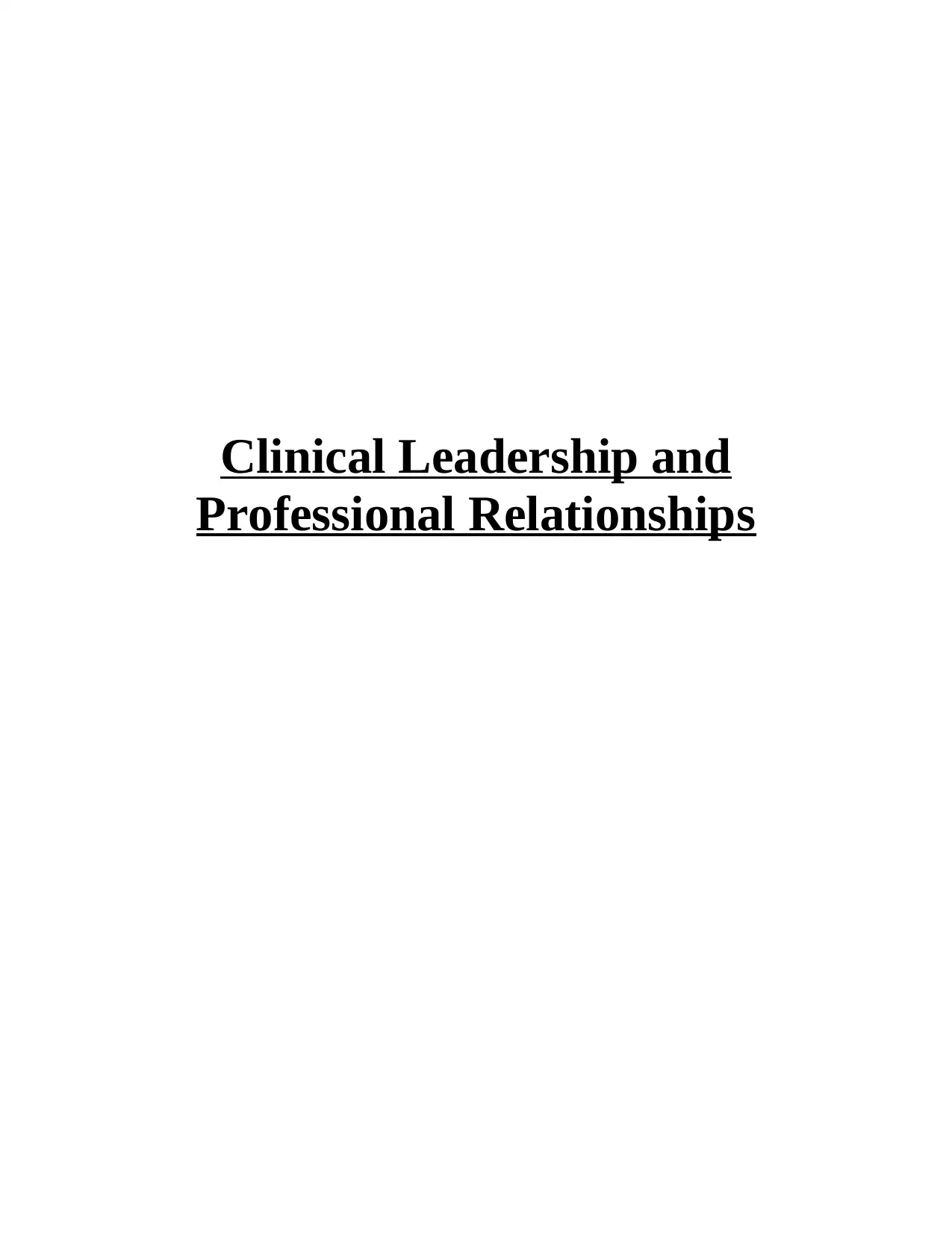
Clinical Leadership and
Professional Relationships
Professional Relationships
Secure Best Marks with AI Grader
Need help grading? Try our AI Grader for instant feedback on your assignments.

Table of Contents
INTRODUCTION...........................................................................................................................3
TASK ..............................................................................................................................................3
Reasons to adopt fully electronic medication system.................................................................3
Kurt Lewin's Change Model.......................................................................................................4
Leadership style..........................................................................................................................6
Aspects of potential resistance to change....................................................................................8
CONCLUSION................................................................................................................................8
REFERENCES................................................................................................................................9
INTRODUCTION...........................................................................................................................3
TASK ..............................................................................................................................................3
Reasons to adopt fully electronic medication system.................................................................3
Kurt Lewin's Change Model.......................................................................................................4
Leadership style..........................................................................................................................6
Aspects of potential resistance to change....................................................................................8
CONCLUSION................................................................................................................................8
REFERENCES................................................................................................................................9
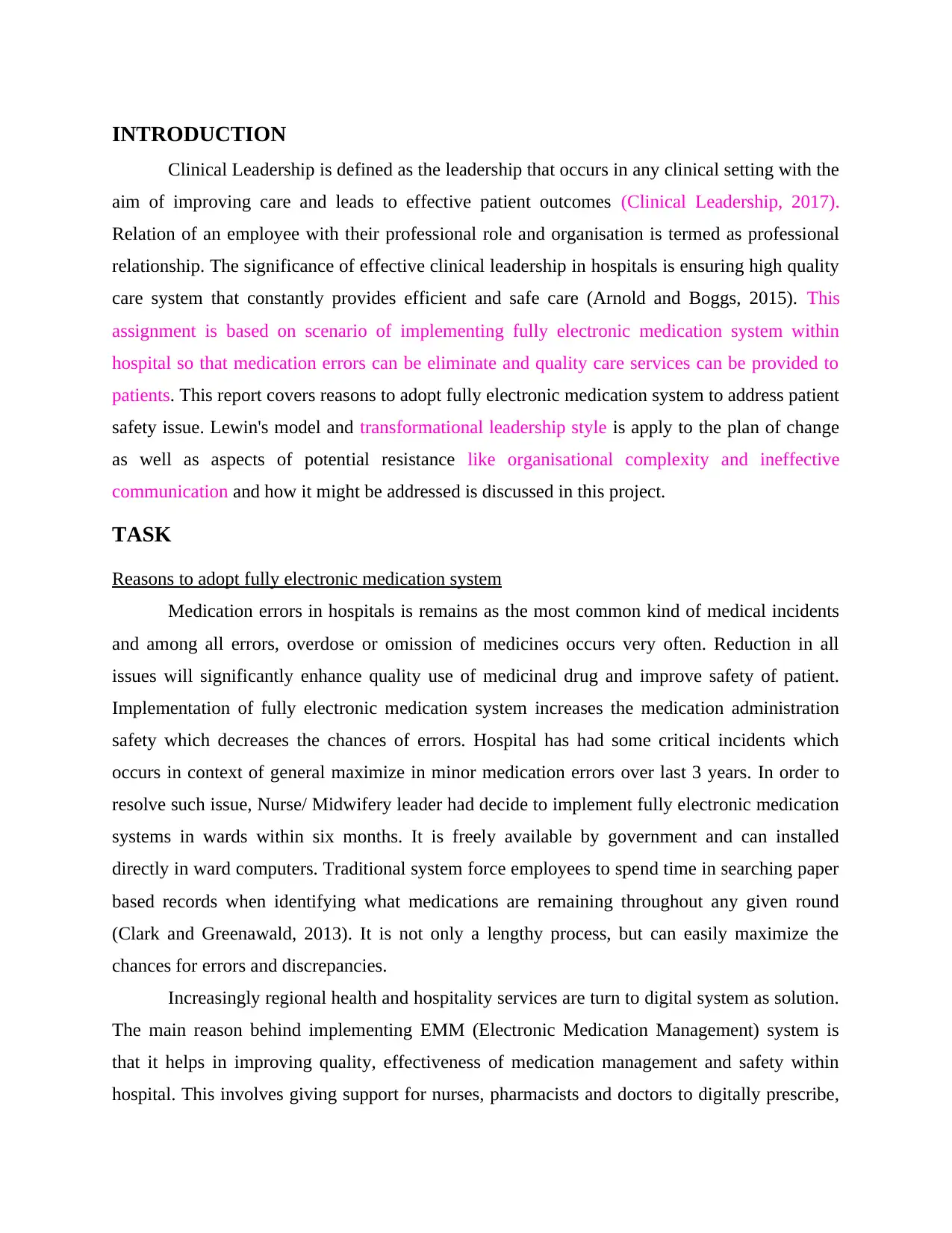
INTRODUCTION
Clinical Leadership is defined as the leadership that occurs in any clinical setting with the
aim of improving care and leads to effective patient outcomes (Clinical Leadership, 2017).
Relation of an employee with their professional role and organisation is termed as professional
relationship. The significance of effective clinical leadership in hospitals is ensuring high quality
care system that constantly provides efficient and safe care (Arnold and Boggs, 2015). This
assignment is based on scenario of implementing fully electronic medication system within
hospital so that medication errors can be eliminate and quality care services can be provided to
patients. This report covers reasons to adopt fully electronic medication system to address patient
safety issue. Lewin's model and transformational leadership style is apply to the plan of change
as well as aspects of potential resistance like organisational complexity and ineffective
communication and how it might be addressed is discussed in this project.
TASK
Reasons to adopt fully electronic medication system
Medication errors in hospitals is remains as the most common kind of medical incidents
and among all errors, overdose or omission of medicines occurs very often. Reduction in all
issues will significantly enhance quality use of medicinal drug and improve safety of patient.
Implementation of fully electronic medication system increases the medication administration
safety which decreases the chances of errors. Hospital has had some critical incidents which
occurs in context of general maximize in minor medication errors over last 3 years. In order to
resolve such issue, Nurse/ Midwifery leader had decide to implement fully electronic medication
systems in wards within six months. It is freely available by government and can installed
directly in ward computers. Traditional system force employees to spend time in searching paper
based records when identifying what medications are remaining throughout any given round
(Clark and Greenawald, 2013). It is not only a lengthy process, but can easily maximize the
chances for errors and discrepancies.
Increasingly regional health and hospitality services are turn to digital system as solution.
The main reason behind implementing EMM (Electronic Medication Management) system is
that it helps in improving quality, effectiveness of medication management and safety within
hospital. This involves giving support for nurses, pharmacists and doctors to digitally prescribe,
Clinical Leadership is defined as the leadership that occurs in any clinical setting with the
aim of improving care and leads to effective patient outcomes (Clinical Leadership, 2017).
Relation of an employee with their professional role and organisation is termed as professional
relationship. The significance of effective clinical leadership in hospitals is ensuring high quality
care system that constantly provides efficient and safe care (Arnold and Boggs, 2015). This
assignment is based on scenario of implementing fully electronic medication system within
hospital so that medication errors can be eliminate and quality care services can be provided to
patients. This report covers reasons to adopt fully electronic medication system to address patient
safety issue. Lewin's model and transformational leadership style is apply to the plan of change
as well as aspects of potential resistance like organisational complexity and ineffective
communication and how it might be addressed is discussed in this project.
TASK
Reasons to adopt fully electronic medication system
Medication errors in hospitals is remains as the most common kind of medical incidents
and among all errors, overdose or omission of medicines occurs very often. Reduction in all
issues will significantly enhance quality use of medicinal drug and improve safety of patient.
Implementation of fully electronic medication system increases the medication administration
safety which decreases the chances of errors. Hospital has had some critical incidents which
occurs in context of general maximize in minor medication errors over last 3 years. In order to
resolve such issue, Nurse/ Midwifery leader had decide to implement fully electronic medication
systems in wards within six months. It is freely available by government and can installed
directly in ward computers. Traditional system force employees to spend time in searching paper
based records when identifying what medications are remaining throughout any given round
(Clark and Greenawald, 2013). It is not only a lengthy process, but can easily maximize the
chances for errors and discrepancies.
Increasingly regional health and hospitality services are turn to digital system as solution.
The main reason behind implementing EMM (Electronic Medication Management) system is
that it helps in improving quality, effectiveness of medication management and safety within
hospital. This involves giving support for nurses, pharmacists and doctors to digitally prescribe,
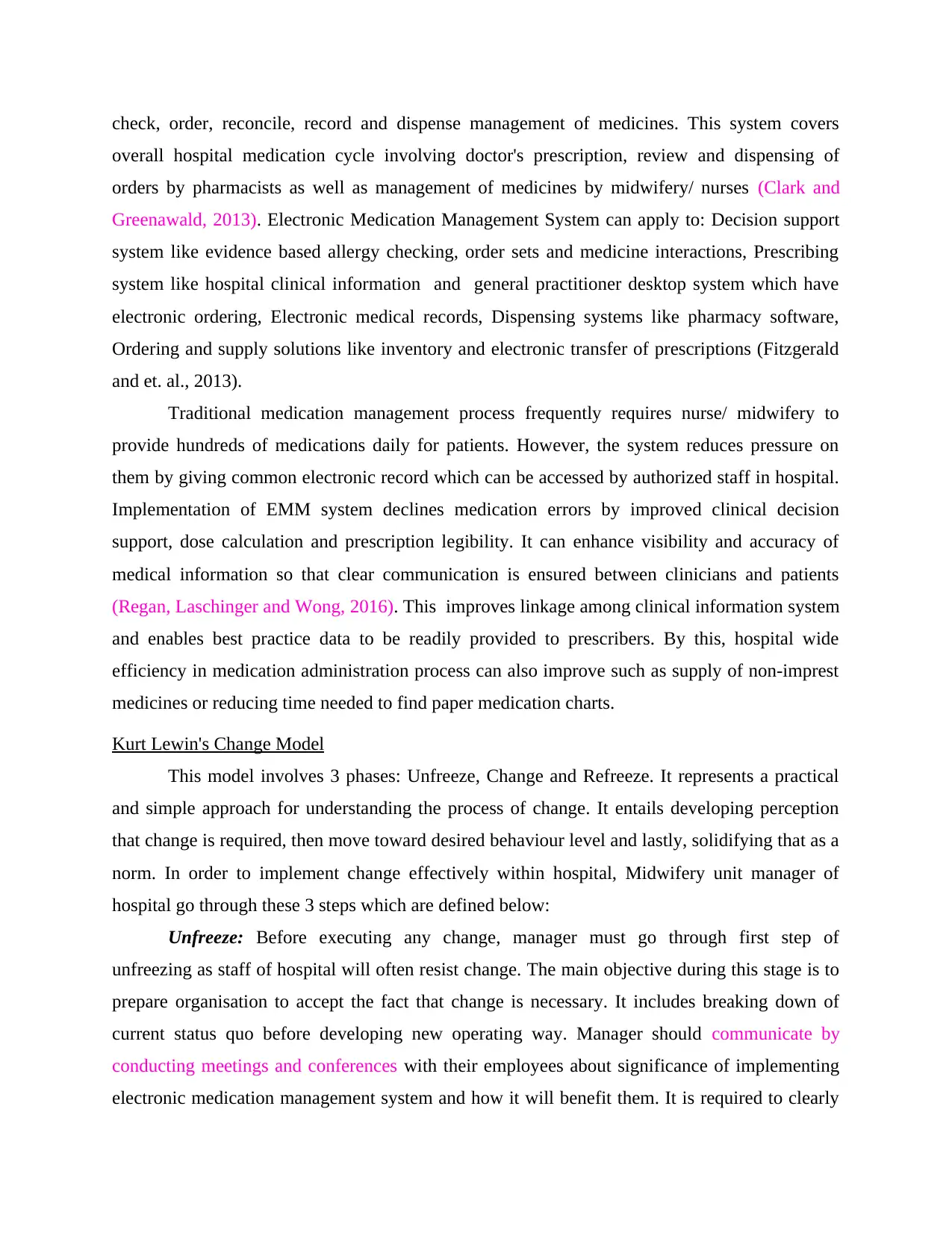
check, order, reconcile, record and dispense management of medicines. This system covers
overall hospital medication cycle involving doctor's prescription, review and dispensing of
orders by pharmacists as well as management of medicines by midwifery/ nurses (Clark and
Greenawald, 2013). Electronic Medication Management System can apply to: Decision support
system like evidence based allergy checking, order sets and medicine interactions, Prescribing
system like hospital clinical information and general practitioner desktop system which have
electronic ordering, Electronic medical records, Dispensing systems like pharmacy software,
Ordering and supply solutions like inventory and electronic transfer of prescriptions (Fitzgerald
and et. al., 2013).
Traditional medication management process frequently requires nurse/ midwifery to
provide hundreds of medications daily for patients. However, the system reduces pressure on
them by giving common electronic record which can be accessed by authorized staff in hospital.
Implementation of EMM system declines medication errors by improved clinical decision
support, dose calculation and prescription legibility. It can enhance visibility and accuracy of
medical information so that clear communication is ensured between clinicians and patients
(Regan, Laschinger and Wong, 2016). This improves linkage among clinical information system
and enables best practice data to be readily provided to prescribers. By this, hospital wide
efficiency in medication administration process can also improve such as supply of non-imprest
medicines or reducing time needed to find paper medication charts.
Kurt Lewin's Change Model
This model involves 3 phases: Unfreeze, Change and Refreeze. It represents a practical
and simple approach for understanding the process of change. It entails developing perception
that change is required, then move toward desired behaviour level and lastly, solidifying that as a
norm. In order to implement change effectively within hospital, Midwifery unit manager of
hospital go through these 3 steps which are defined below:
Unfreeze: Before executing any change, manager must go through first step of
unfreezing as staff of hospital will often resist change. The main objective during this stage is to
prepare organisation to accept the fact that change is necessary. It includes breaking down of
current status quo before developing new operating way. Manager should communicate by
conducting meetings and conferences with their employees about significance of implementing
electronic medication management system and how it will benefit them. It is required to clearly
overall hospital medication cycle involving doctor's prescription, review and dispensing of
orders by pharmacists as well as management of medicines by midwifery/ nurses (Clark and
Greenawald, 2013). Electronic Medication Management System can apply to: Decision support
system like evidence based allergy checking, order sets and medicine interactions, Prescribing
system like hospital clinical information and general practitioner desktop system which have
electronic ordering, Electronic medical records, Dispensing systems like pharmacy software,
Ordering and supply solutions like inventory and electronic transfer of prescriptions (Fitzgerald
and et. al., 2013).
Traditional medication management process frequently requires nurse/ midwifery to
provide hundreds of medications daily for patients. However, the system reduces pressure on
them by giving common electronic record which can be accessed by authorized staff in hospital.
Implementation of EMM system declines medication errors by improved clinical decision
support, dose calculation and prescription legibility. It can enhance visibility and accuracy of
medical information so that clear communication is ensured between clinicians and patients
(Regan, Laschinger and Wong, 2016). This improves linkage among clinical information system
and enables best practice data to be readily provided to prescribers. By this, hospital wide
efficiency in medication administration process can also improve such as supply of non-imprest
medicines or reducing time needed to find paper medication charts.
Kurt Lewin's Change Model
This model involves 3 phases: Unfreeze, Change and Refreeze. It represents a practical
and simple approach for understanding the process of change. It entails developing perception
that change is required, then move toward desired behaviour level and lastly, solidifying that as a
norm. In order to implement change effectively within hospital, Midwifery unit manager of
hospital go through these 3 steps which are defined below:
Unfreeze: Before executing any change, manager must go through first step of
unfreezing as staff of hospital will often resist change. The main objective during this stage is to
prepare organisation to accept the fact that change is necessary. It includes breaking down of
current status quo before developing new operating way. Manager should communicate by
conducting meetings and conferences with their employees about significance of implementing
electronic medication management system and how it will benefit them. It is required to clearly
Secure Best Marks with AI Grader
Need help grading? Try our AI Grader for instant feedback on your assignments.
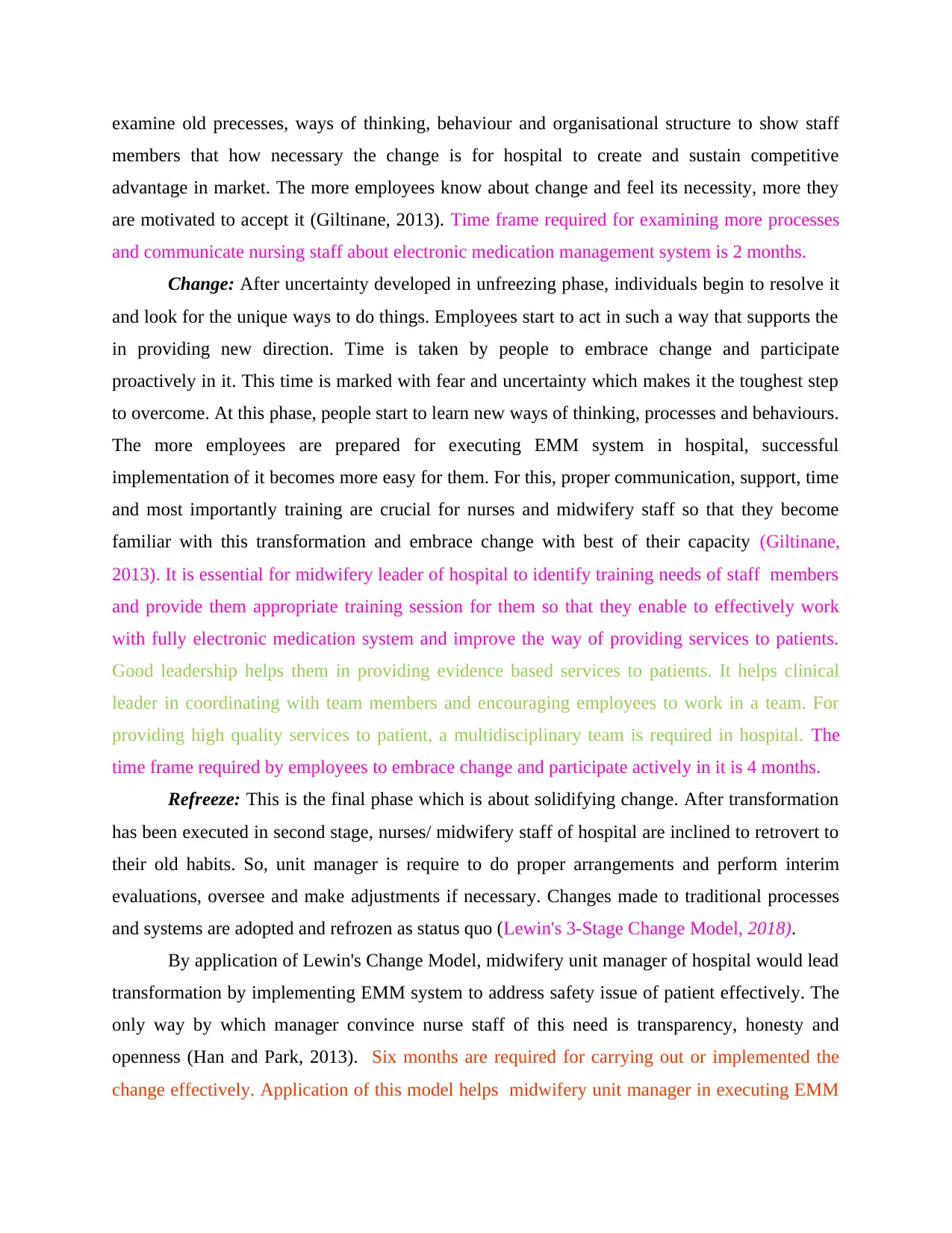
examine old precesses, ways of thinking, behaviour and organisational structure to show staff
members that how necessary the change is for hospital to create and sustain competitive
advantage in market. The more employees know about change and feel its necessity, more they
are motivated to accept it (Giltinane, 2013). Time frame required for examining more processes
and communicate nursing staff about electronic medication management system is 2 months.
Change: After uncertainty developed in unfreezing phase, individuals begin to resolve it
and look for the unique ways to do things. Employees start to act in such a way that supports the
in providing new direction. Time is taken by people to embrace change and participate
proactively in it. This time is marked with fear and uncertainty which makes it the toughest step
to overcome. At this phase, people start to learn new ways of thinking, processes and behaviours.
The more employees are prepared for executing EMM system in hospital, successful
implementation of it becomes more easy for them. For this, proper communication, support, time
and most importantly training are crucial for nurses and midwifery staff so that they become
familiar with this transformation and embrace change with best of their capacity (Giltinane,
2013). It is essential for midwifery leader of hospital to identify training needs of staff members
and provide them appropriate training session for them so that they enable to effectively work
with fully electronic medication system and improve the way of providing services to patients.
Good leadership helps them in providing evidence based services to patients. It helps clinical
leader in coordinating with team members and encouraging employees to work in a team. For
providing high quality services to patient, a multidisciplinary team is required in hospital. The
time frame required by employees to embrace change and participate actively in it is 4 months.
Refreeze: This is the final phase which is about solidifying change. After transformation
has been executed in second stage, nurses/ midwifery staff of hospital are inclined to retrovert to
their old habits. So, unit manager is require to do proper arrangements and perform interim
evaluations, oversee and make adjustments if necessary. Changes made to traditional processes
and systems are adopted and refrozen as status quo (Lewin's 3-Stage Change Model, 2018).
By application of Lewin's Change Model, midwifery unit manager of hospital would lead
transformation by implementing EMM system to address safety issue of patient effectively. The
only way by which manager convince nurse staff of this need is transparency, honesty and
openness (Han and Park, 2013). Six months are required for carrying out or implemented the
change effectively. Application of this model helps midwifery unit manager in executing EMM
members that how necessary the change is for hospital to create and sustain competitive
advantage in market. The more employees know about change and feel its necessity, more they
are motivated to accept it (Giltinane, 2013). Time frame required for examining more processes
and communicate nursing staff about electronic medication management system is 2 months.
Change: After uncertainty developed in unfreezing phase, individuals begin to resolve it
and look for the unique ways to do things. Employees start to act in such a way that supports the
in providing new direction. Time is taken by people to embrace change and participate
proactively in it. This time is marked with fear and uncertainty which makes it the toughest step
to overcome. At this phase, people start to learn new ways of thinking, processes and behaviours.
The more employees are prepared for executing EMM system in hospital, successful
implementation of it becomes more easy for them. For this, proper communication, support, time
and most importantly training are crucial for nurses and midwifery staff so that they become
familiar with this transformation and embrace change with best of their capacity (Giltinane,
2013). It is essential for midwifery leader of hospital to identify training needs of staff members
and provide them appropriate training session for them so that they enable to effectively work
with fully electronic medication system and improve the way of providing services to patients.
Good leadership helps them in providing evidence based services to patients. It helps clinical
leader in coordinating with team members and encouraging employees to work in a team. For
providing high quality services to patient, a multidisciplinary team is required in hospital. The
time frame required by employees to embrace change and participate actively in it is 4 months.
Refreeze: This is the final phase which is about solidifying change. After transformation
has been executed in second stage, nurses/ midwifery staff of hospital are inclined to retrovert to
their old habits. So, unit manager is require to do proper arrangements and perform interim
evaluations, oversee and make adjustments if necessary. Changes made to traditional processes
and systems are adopted and refrozen as status quo (Lewin's 3-Stage Change Model, 2018).
By application of Lewin's Change Model, midwifery unit manager of hospital would lead
transformation by implementing EMM system to address safety issue of patient effectively. The
only way by which manager convince nurse staff of this need is transparency, honesty and
openness (Han and Park, 2013). Six months are required for carrying out or implemented the
change effectively. Application of this model helps midwifery unit manager in executing EMM

System in organisation within 6 months. The first milestone of executing it is completed in 3
months. Application of transformational leadership style helps clinician in motivating and
inspiring employees to adopt change.
Leadership style
Transformational leadership: In this style, leader works with team to determine required
change, create vision to direct it by inspiration and implement transformation in tandem with
group member's commitment. Application of this leadership style provides midwifery unit
manager with skills that helps in making improvements in safety and quality of patient care,
while improving their career satisfaction. This leadership style helps manager in implementing
change effectively within firm by making and executing appropriate strategies. It assists them in
encouraging change among staff members. The main reason behind selecting transformational
leadership style is that it helps midwifery unit manager to implement change effectively and
communicating the same to employees so that they enable to accept it (Hutchinson and Hurley,
2013). By communicating benefits of fully electronic medication system, leader can encourage
their staff members to adopt the change effectively and cope up with it.
Scenario: The hospital has had some critical medication incidents. These occurs due to
increase in minor medication errors. Ineffective leadership by leader of hospital is the main cause
of incurring incidents. The another reason is lack of team working and coordination among
nurses and midwifery manager. Patients are not getting evidenced based care which puts a
question mark on hospital regarding safety of patient. Organisation needs to implement change
within workplace by adopting electronic medication system, but it is not easy as employees resist
to any change takes place within hospital. The issue of target leadership might be present in
organisation that makes difference between academic nurse and a great nurse.
Application of leadership style in scenario:
Leadership is all about developing oneself, teams and attaining goals. It is about taking
responsibility and making effective decisions so that team working can be encouraged and
goals can be attain. Selection of good leadership by leader can only be the solution of motivating
employees to adopt change and work with commitment towards providing high quality care
services to their patients. Effective leadership is important as it makes a difference between staff
flourishing and stagnant. In order to overcome the issue, it is very necessary for midwifery leader
to adopt effective leadership style. In health care sector, style of leadership plays vital role in
months. Application of transformational leadership style helps clinician in motivating and
inspiring employees to adopt change.
Leadership style
Transformational leadership: In this style, leader works with team to determine required
change, create vision to direct it by inspiration and implement transformation in tandem with
group member's commitment. Application of this leadership style provides midwifery unit
manager with skills that helps in making improvements in safety and quality of patient care,
while improving their career satisfaction. This leadership style helps manager in implementing
change effectively within firm by making and executing appropriate strategies. It assists them in
encouraging change among staff members. The main reason behind selecting transformational
leadership style is that it helps midwifery unit manager to implement change effectively and
communicating the same to employees so that they enable to accept it (Hutchinson and Hurley,
2013). By communicating benefits of fully electronic medication system, leader can encourage
their staff members to adopt the change effectively and cope up with it.
Scenario: The hospital has had some critical medication incidents. These occurs due to
increase in minor medication errors. Ineffective leadership by leader of hospital is the main cause
of incurring incidents. The another reason is lack of team working and coordination among
nurses and midwifery manager. Patients are not getting evidenced based care which puts a
question mark on hospital regarding safety of patient. Organisation needs to implement change
within workplace by adopting electronic medication system, but it is not easy as employees resist
to any change takes place within hospital. The issue of target leadership might be present in
organisation that makes difference between academic nurse and a great nurse.
Application of leadership style in scenario:
Leadership is all about developing oneself, teams and attaining goals. It is about taking
responsibility and making effective decisions so that team working can be encouraged and
goals can be attain. Selection of good leadership by leader can only be the solution of motivating
employees to adopt change and work with commitment towards providing high quality care
services to their patients. Effective leadership is important as it makes a difference between staff
flourishing and stagnant. In order to overcome the issue, it is very necessary for midwifery leader
to adopt effective leadership style. In health care sector, style of leadership plays vital role in
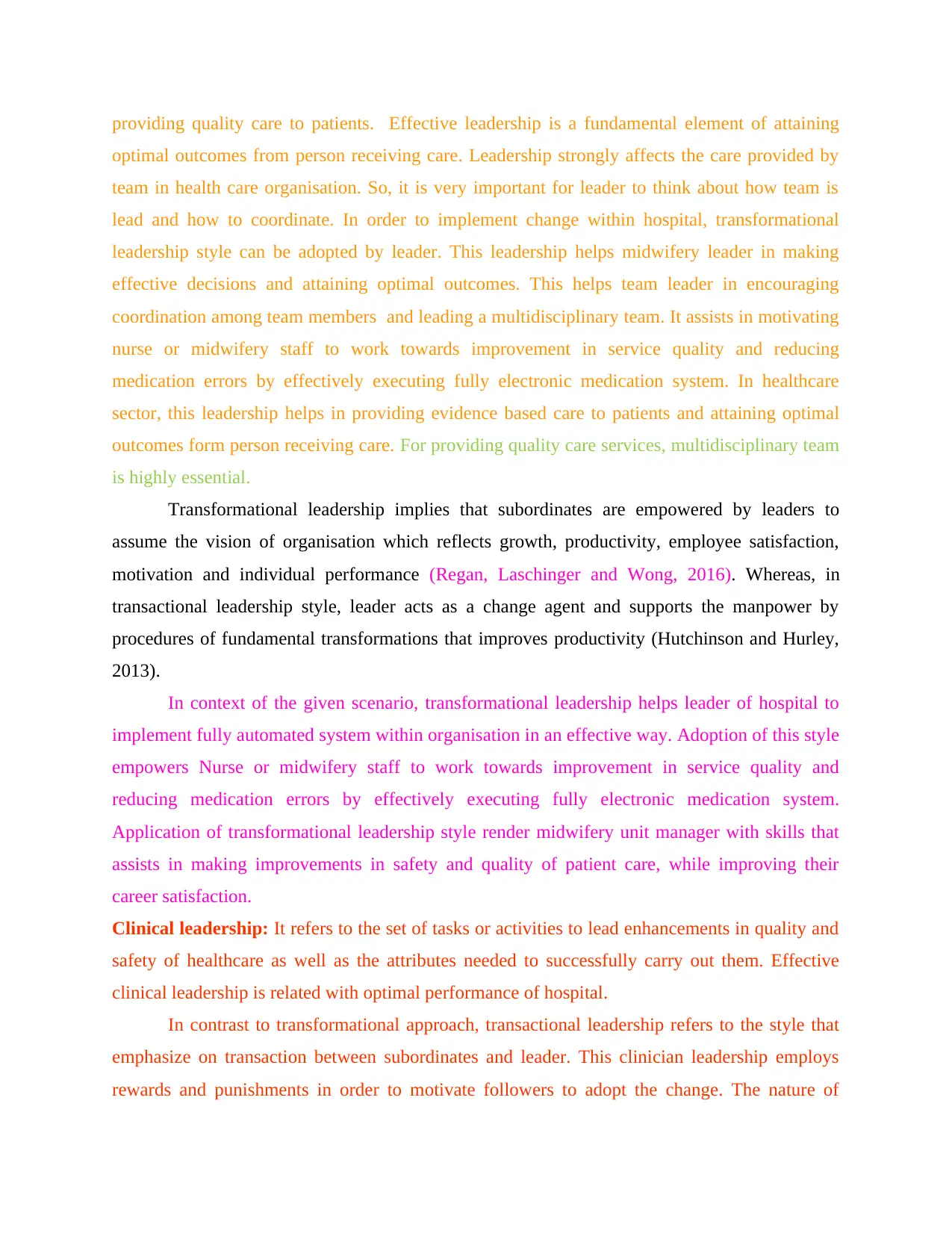
providing quality care to patients. Effective leadership is a fundamental element of attaining
optimal outcomes from person receiving care. Leadership strongly affects the care provided by
team in health care organisation. So, it is very important for leader to think about how team is
lead and how to coordinate. In order to implement change within hospital, transformational
leadership style can be adopted by leader. This leadership helps midwifery leader in making
effective decisions and attaining optimal outcomes. This helps team leader in encouraging
coordination among team members and leading a multidisciplinary team. It assists in motivating
nurse or midwifery staff to work towards improvement in service quality and reducing
medication errors by effectively executing fully electronic medication system. In healthcare
sector, this leadership helps in providing evidence based care to patients and attaining optimal
outcomes form person receiving care. For providing quality care services, multidisciplinary team
is highly essential.
Transformational leadership implies that subordinates are empowered by leaders to
assume the vision of organisation which reflects growth, productivity, employee satisfaction,
motivation and individual performance (Regan, Laschinger and Wong, 2016). Whereas, in
transactional leadership style, leader acts as a change agent and supports the manpower by
procedures of fundamental transformations that improves productivity (Hutchinson and Hurley,
2013).
In context of the given scenario, transformational leadership helps leader of hospital to
implement fully automated system within organisation in an effective way. Adoption of this style
empowers Nurse or midwifery staff to work towards improvement in service quality and
reducing medication errors by effectively executing fully electronic medication system.
Application of transformational leadership style render midwifery unit manager with skills that
assists in making improvements in safety and quality of patient care, while improving their
career satisfaction.
Clinical leadership: It refers to the set of tasks or activities to lead enhancements in quality and
safety of healthcare as well as the attributes needed to successfully carry out them. Effective
clinical leadership is related with optimal performance of hospital.
In contrast to transformational approach, transactional leadership refers to the style that
emphasize on transaction between subordinates and leader. This clinician leadership employs
rewards and punishments in order to motivate followers to adopt the change. The nature of
optimal outcomes from person receiving care. Leadership strongly affects the care provided by
team in health care organisation. So, it is very important for leader to think about how team is
lead and how to coordinate. In order to implement change within hospital, transformational
leadership style can be adopted by leader. This leadership helps midwifery leader in making
effective decisions and attaining optimal outcomes. This helps team leader in encouraging
coordination among team members and leading a multidisciplinary team. It assists in motivating
nurse or midwifery staff to work towards improvement in service quality and reducing
medication errors by effectively executing fully electronic medication system. In healthcare
sector, this leadership helps in providing evidence based care to patients and attaining optimal
outcomes form person receiving care. For providing quality care services, multidisciplinary team
is highly essential.
Transformational leadership implies that subordinates are empowered by leaders to
assume the vision of organisation which reflects growth, productivity, employee satisfaction,
motivation and individual performance (Regan, Laschinger and Wong, 2016). Whereas, in
transactional leadership style, leader acts as a change agent and supports the manpower by
procedures of fundamental transformations that improves productivity (Hutchinson and Hurley,
2013).
In context of the given scenario, transformational leadership helps leader of hospital to
implement fully automated system within organisation in an effective way. Adoption of this style
empowers Nurse or midwifery staff to work towards improvement in service quality and
reducing medication errors by effectively executing fully electronic medication system.
Application of transformational leadership style render midwifery unit manager with skills that
assists in making improvements in safety and quality of patient care, while improving their
career satisfaction.
Clinical leadership: It refers to the set of tasks or activities to lead enhancements in quality and
safety of healthcare as well as the attributes needed to successfully carry out them. Effective
clinical leadership is related with optimal performance of hospital.
In contrast to transformational approach, transactional leadership refers to the style that
emphasize on transaction between subordinates and leader. This clinician leadership employs
rewards and punishments in order to motivate followers to adopt the change. The nature of
Paraphrase This Document
Need a fresh take? Get an instant paraphrase of this document with our AI Paraphraser
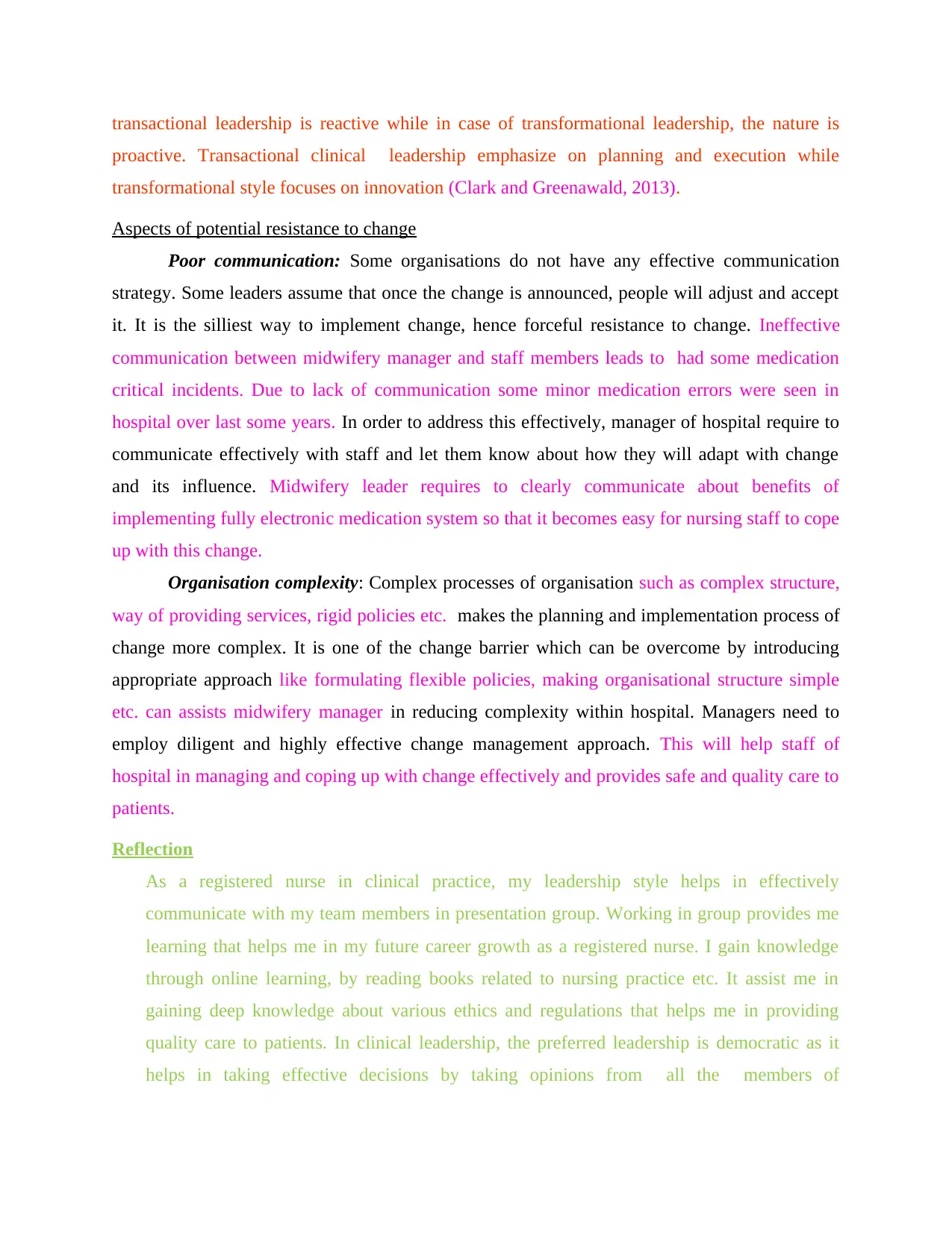
transactional leadership is reactive while in case of transformational leadership, the nature is
proactive. Transactional clinical leadership emphasize on planning and execution while
transformational style focuses on innovation (Clark and Greenawald, 2013).
Aspects of potential resistance to change
Poor communication: Some organisations do not have any effective communication
strategy. Some leaders assume that once the change is announced, people will adjust and accept
it. It is the silliest way to implement change, hence forceful resistance to change. Ineffective
communication between midwifery manager and staff members leads to had some medication
critical incidents. Due to lack of communication some minor medication errors were seen in
hospital over last some years. In order to address this effectively, manager of hospital require to
communicate effectively with staff and let them know about how they will adapt with change
and its influence. Midwifery leader requires to clearly communicate about benefits of
implementing fully electronic medication system so that it becomes easy for nursing staff to cope
up with this change.
Organisation complexity: Complex processes of organisation such as complex structure,
way of providing services, rigid policies etc. makes the planning and implementation process of
change more complex. It is one of the change barrier which can be overcome by introducing
appropriate approach like formulating flexible policies, making organisational structure simple
etc. can assists midwifery manager in reducing complexity within hospital. Managers need to
employ diligent and highly effective change management approach. This will help staff of
hospital in managing and coping up with change effectively and provides safe and quality care to
patients.
Reflection
As a registered nurse in clinical practice, my leadership style helps in effectively
communicate with my team members in presentation group. Working in group provides me
learning that helps me in my future career growth as a registered nurse. I gain knowledge
through online learning, by reading books related to nursing practice etc. It assist me in
gaining deep knowledge about various ethics and regulations that helps me in providing
quality care to patients. In clinical leadership, the preferred leadership is democratic as it
helps in taking effective decisions by taking opinions from all the members of
proactive. Transactional clinical leadership emphasize on planning and execution while
transformational style focuses on innovation (Clark and Greenawald, 2013).
Aspects of potential resistance to change
Poor communication: Some organisations do not have any effective communication
strategy. Some leaders assume that once the change is announced, people will adjust and accept
it. It is the silliest way to implement change, hence forceful resistance to change. Ineffective
communication between midwifery manager and staff members leads to had some medication
critical incidents. Due to lack of communication some minor medication errors were seen in
hospital over last some years. In order to address this effectively, manager of hospital require to
communicate effectively with staff and let them know about how they will adapt with change
and its influence. Midwifery leader requires to clearly communicate about benefits of
implementing fully electronic medication system so that it becomes easy for nursing staff to cope
up with this change.
Organisation complexity: Complex processes of organisation such as complex structure,
way of providing services, rigid policies etc. makes the planning and implementation process of
change more complex. It is one of the change barrier which can be overcome by introducing
appropriate approach like formulating flexible policies, making organisational structure simple
etc. can assists midwifery manager in reducing complexity within hospital. Managers need to
employ diligent and highly effective change management approach. This will help staff of
hospital in managing and coping up with change effectively and provides safe and quality care to
patients.
Reflection
As a registered nurse in clinical practice, my leadership style helps in effectively
communicate with my team members in presentation group. Working in group provides me
learning that helps me in my future career growth as a registered nurse. I gain knowledge
through online learning, by reading books related to nursing practice etc. It assist me in
gaining deep knowledge about various ethics and regulations that helps me in providing
quality care to patients. In clinical leadership, the preferred leadership is democratic as it
helps in taking effective decisions by taking opinions from all the members of
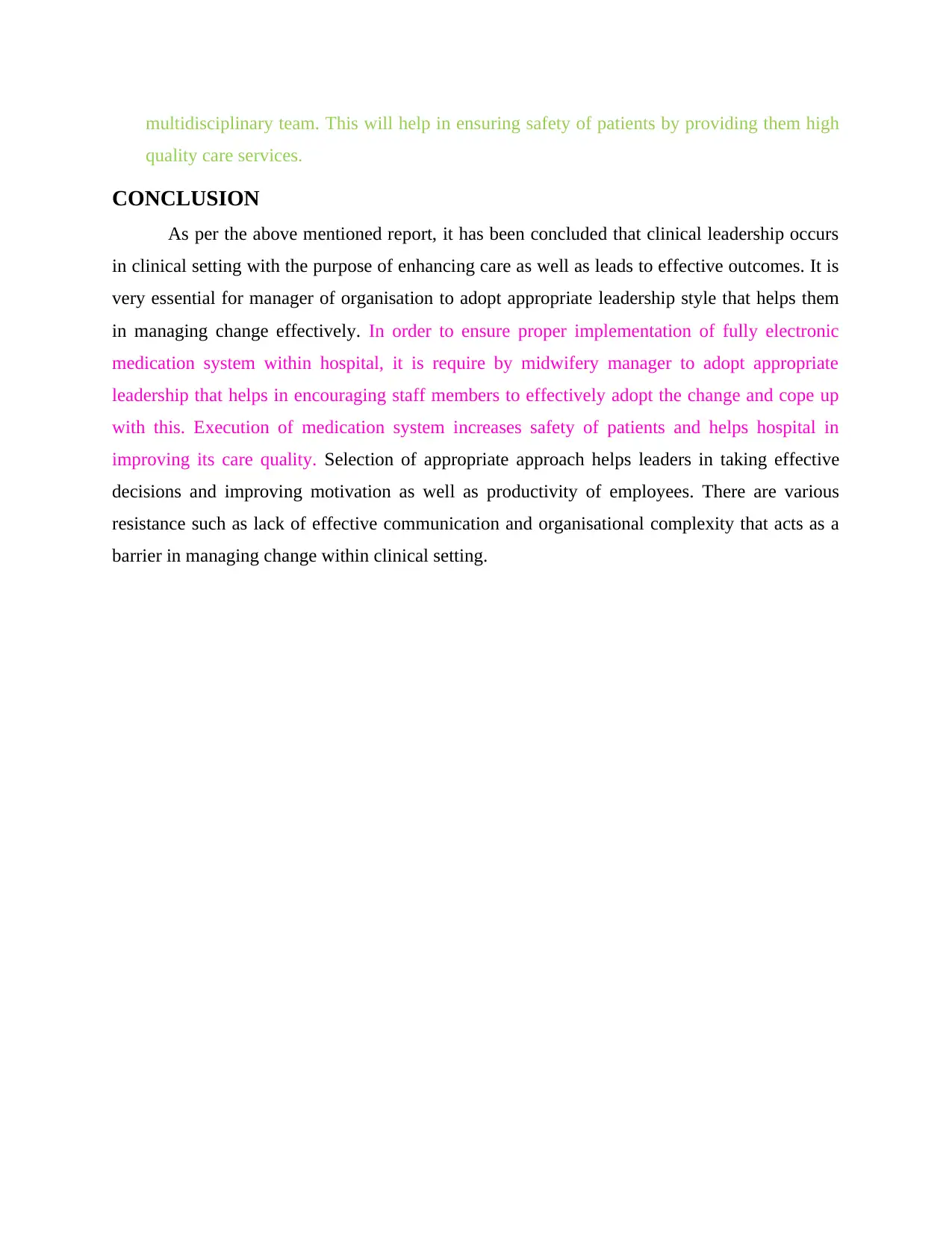
multidisciplinary team. This will help in ensuring safety of patients by providing them high
quality care services.
CONCLUSION
As per the above mentioned report, it has been concluded that clinical leadership occurs
in clinical setting with the purpose of enhancing care as well as leads to effective outcomes. It is
very essential for manager of organisation to adopt appropriate leadership style that helps them
in managing change effectively. In order to ensure proper implementation of fully electronic
medication system within hospital, it is require by midwifery manager to adopt appropriate
leadership that helps in encouraging staff members to effectively adopt the change and cope up
with this. Execution of medication system increases safety of patients and helps hospital in
improving its care quality. Selection of appropriate approach helps leaders in taking effective
decisions and improving motivation as well as productivity of employees. There are various
resistance such as lack of effective communication and organisational complexity that acts as a
barrier in managing change within clinical setting.
quality care services.
CONCLUSION
As per the above mentioned report, it has been concluded that clinical leadership occurs
in clinical setting with the purpose of enhancing care as well as leads to effective outcomes. It is
very essential for manager of organisation to adopt appropriate leadership style that helps them
in managing change effectively. In order to ensure proper implementation of fully electronic
medication system within hospital, it is require by midwifery manager to adopt appropriate
leadership that helps in encouraging staff members to effectively adopt the change and cope up
with this. Execution of medication system increases safety of patients and helps hospital in
improving its care quality. Selection of appropriate approach helps leaders in taking effective
decisions and improving motivation as well as productivity of employees. There are various
resistance such as lack of effective communication and organisational complexity that acts as a
barrier in managing change within clinical setting.

Secure Best Marks with AI Grader
Need help grading? Try our AI Grader for instant feedback on your assignments.
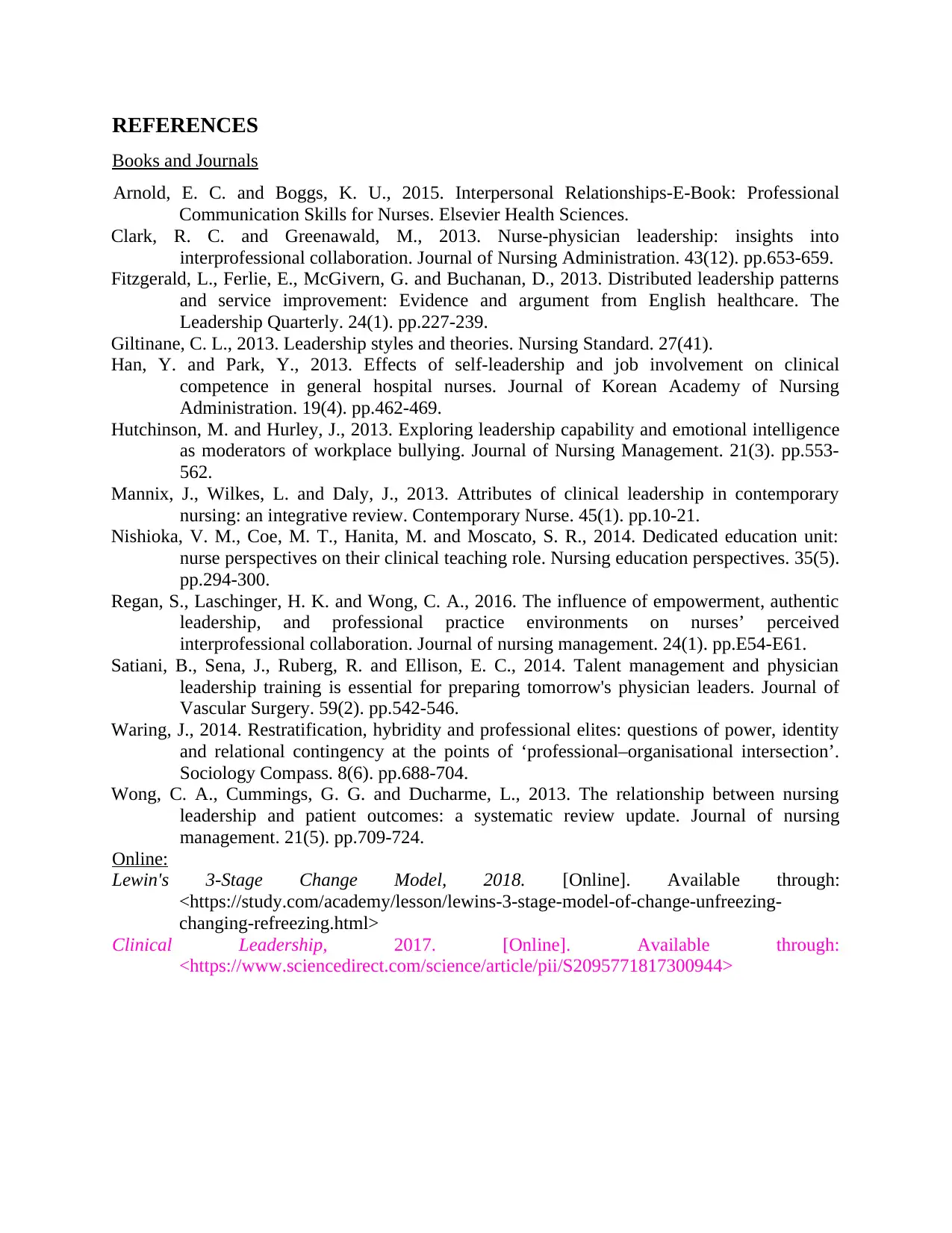
REFERENCES
Books and Journals
Arnold, E. C. and Boggs, K. U., 2015. Interpersonal Relationships-E-Book: Professional
Communication Skills for Nurses. Elsevier Health Sciences.
Clark, R. C. and Greenawald, M., 2013. Nurse-physician leadership: insights into
interprofessional collaboration. Journal of Nursing Administration. 43(12). pp.653-659.
Fitzgerald, L., Ferlie, E., McGivern, G. and Buchanan, D., 2013. Distributed leadership patterns
and service improvement: Evidence and argument from English healthcare. The
Leadership Quarterly. 24(1). pp.227-239.
Giltinane, C. L., 2013. Leadership styles and theories. Nursing Standard. 27(41).
Han, Y. and Park, Y., 2013. Effects of self-leadership and job involvement on clinical
competence in general hospital nurses. Journal of Korean Academy of Nursing
Administration. 19(4). pp.462-469.
Hutchinson, M. and Hurley, J., 2013. Exploring leadership capability and emotional intelligence
as moderators of workplace bullying. Journal of Nursing Management. 21(3). pp.553-
562.
Mannix, J., Wilkes, L. and Daly, J., 2013. Attributes of clinical leadership in contemporary
nursing: an integrative review. Contemporary Nurse. 45(1). pp.10-21.
Nishioka, V. M., Coe, M. T., Hanita, M. and Moscato, S. R., 2014. Dedicated education unit:
nurse perspectives on their clinical teaching role. Nursing education perspectives. 35(5).
pp.294-300.
Regan, S., Laschinger, H. K. and Wong, C. A., 2016. The influence of empowerment, authentic
leadership, and professional practice environments on nurses’ perceived
interprofessional collaboration. Journal of nursing management. 24(1). pp.E54-E61.
Satiani, B., Sena, J., Ruberg, R. and Ellison, E. C., 2014. Talent management and physician
leadership training is essential for preparing tomorrow's physician leaders. Journal of
Vascular Surgery. 59(2). pp.542-546.
Waring, J., 2014. Restratification, hybridity and professional elites: questions of power, identity
and relational contingency at the points of ‘professional–organisational intersection’.
Sociology Compass. 8(6). pp.688-704.
Wong, C. A., Cummings, G. G. and Ducharme, L., 2013. The relationship between nursing
leadership and patient outcomes: a systematic review update. Journal of nursing
management. 21(5). pp.709-724.
Online:
Lewin's 3-Stage Change Model, 2018. [Online]. Available through:
<https://study.com/academy/lesson/lewins-3-stage-model-of-change-unfreezing-
changing-refreezing.html>
Clinical Leadership, 2017. [Online]. Available through:
<https://www.sciencedirect.com/science/article/pii/S2095771817300944>
Books and Journals
Arnold, E. C. and Boggs, K. U., 2015. Interpersonal Relationships-E-Book: Professional
Communication Skills for Nurses. Elsevier Health Sciences.
Clark, R. C. and Greenawald, M., 2013. Nurse-physician leadership: insights into
interprofessional collaboration. Journal of Nursing Administration. 43(12). pp.653-659.
Fitzgerald, L., Ferlie, E., McGivern, G. and Buchanan, D., 2013. Distributed leadership patterns
and service improvement: Evidence and argument from English healthcare. The
Leadership Quarterly. 24(1). pp.227-239.
Giltinane, C. L., 2013. Leadership styles and theories. Nursing Standard. 27(41).
Han, Y. and Park, Y., 2013. Effects of self-leadership and job involvement on clinical
competence in general hospital nurses. Journal of Korean Academy of Nursing
Administration. 19(4). pp.462-469.
Hutchinson, M. and Hurley, J., 2013. Exploring leadership capability and emotional intelligence
as moderators of workplace bullying. Journal of Nursing Management. 21(3). pp.553-
562.
Mannix, J., Wilkes, L. and Daly, J., 2013. Attributes of clinical leadership in contemporary
nursing: an integrative review. Contemporary Nurse. 45(1). pp.10-21.
Nishioka, V. M., Coe, M. T., Hanita, M. and Moscato, S. R., 2014. Dedicated education unit:
nurse perspectives on their clinical teaching role. Nursing education perspectives. 35(5).
pp.294-300.
Regan, S., Laschinger, H. K. and Wong, C. A., 2016. The influence of empowerment, authentic
leadership, and professional practice environments on nurses’ perceived
interprofessional collaboration. Journal of nursing management. 24(1). pp.E54-E61.
Satiani, B., Sena, J., Ruberg, R. and Ellison, E. C., 2014. Talent management and physician
leadership training is essential for preparing tomorrow's physician leaders. Journal of
Vascular Surgery. 59(2). pp.542-546.
Waring, J., 2014. Restratification, hybridity and professional elites: questions of power, identity
and relational contingency at the points of ‘professional–organisational intersection’.
Sociology Compass. 8(6). pp.688-704.
Wong, C. A., Cummings, G. G. and Ducharme, L., 2013. The relationship between nursing
leadership and patient outcomes: a systematic review update. Journal of nursing
management. 21(5). pp.709-724.
Online:
Lewin's 3-Stage Change Model, 2018. [Online]. Available through:
<https://study.com/academy/lesson/lewins-3-stage-model-of-change-unfreezing-
changing-refreezing.html>
Clinical Leadership, 2017. [Online]. Available through:
<https://www.sciencedirect.com/science/article/pii/S2095771817300944>
1 out of 11
Related Documents
Your All-in-One AI-Powered Toolkit for Academic Success.
+13062052269
info@desklib.com
Available 24*7 on WhatsApp / Email
![[object Object]](/_next/static/media/star-bottom.7253800d.svg)
Unlock your academic potential
© 2024 | Zucol Services PVT LTD | All rights reserved.





